 Mike Self
.
December 27, 2021
.
Department
Mike Self
.
December 27, 2021
.
Department
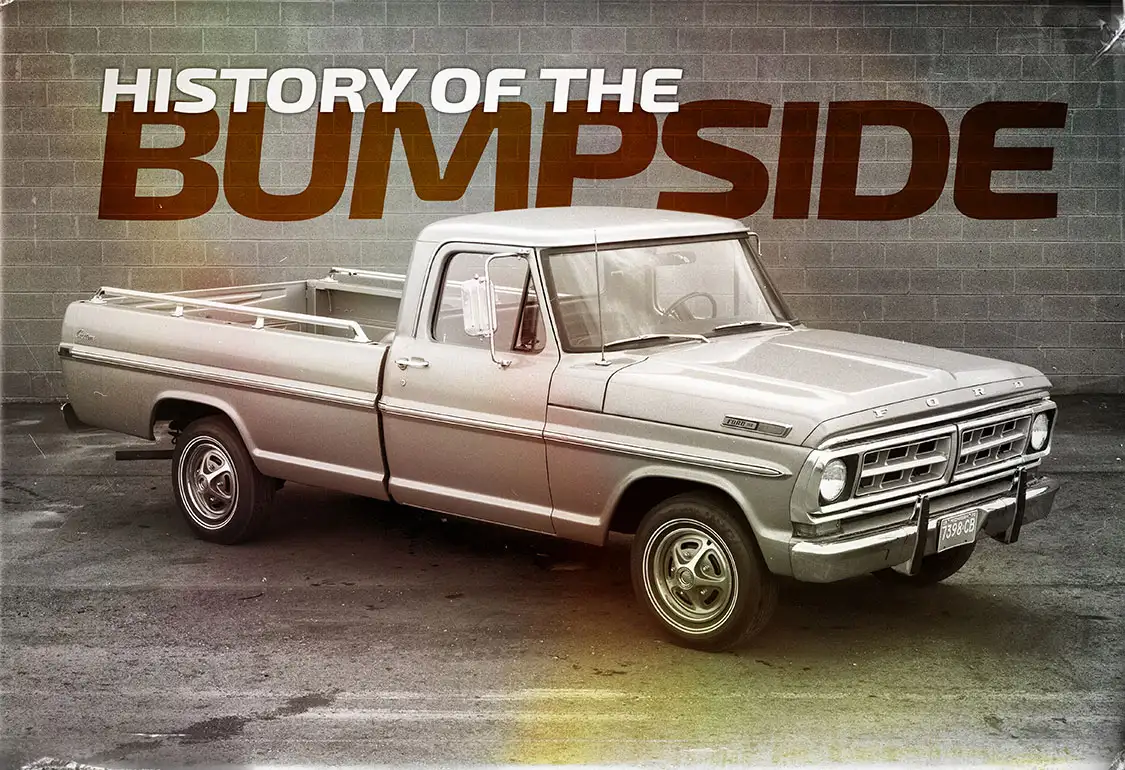
The year 1967 was an interesting one. The Vietnam War waged on, as did the anti-war protests amid the burgeoning “peace and love” movement of the late ’60s. The Doors’ self-titled album hits music store shelves, and Super Bowl I takes place, with the Green Bay Packers defeating the Kansas City Chiefs. In other football news, a rising star by the name of O.J. Simpson dazzles crowds as running back for USC, winning the Heisman Trophy the following year.
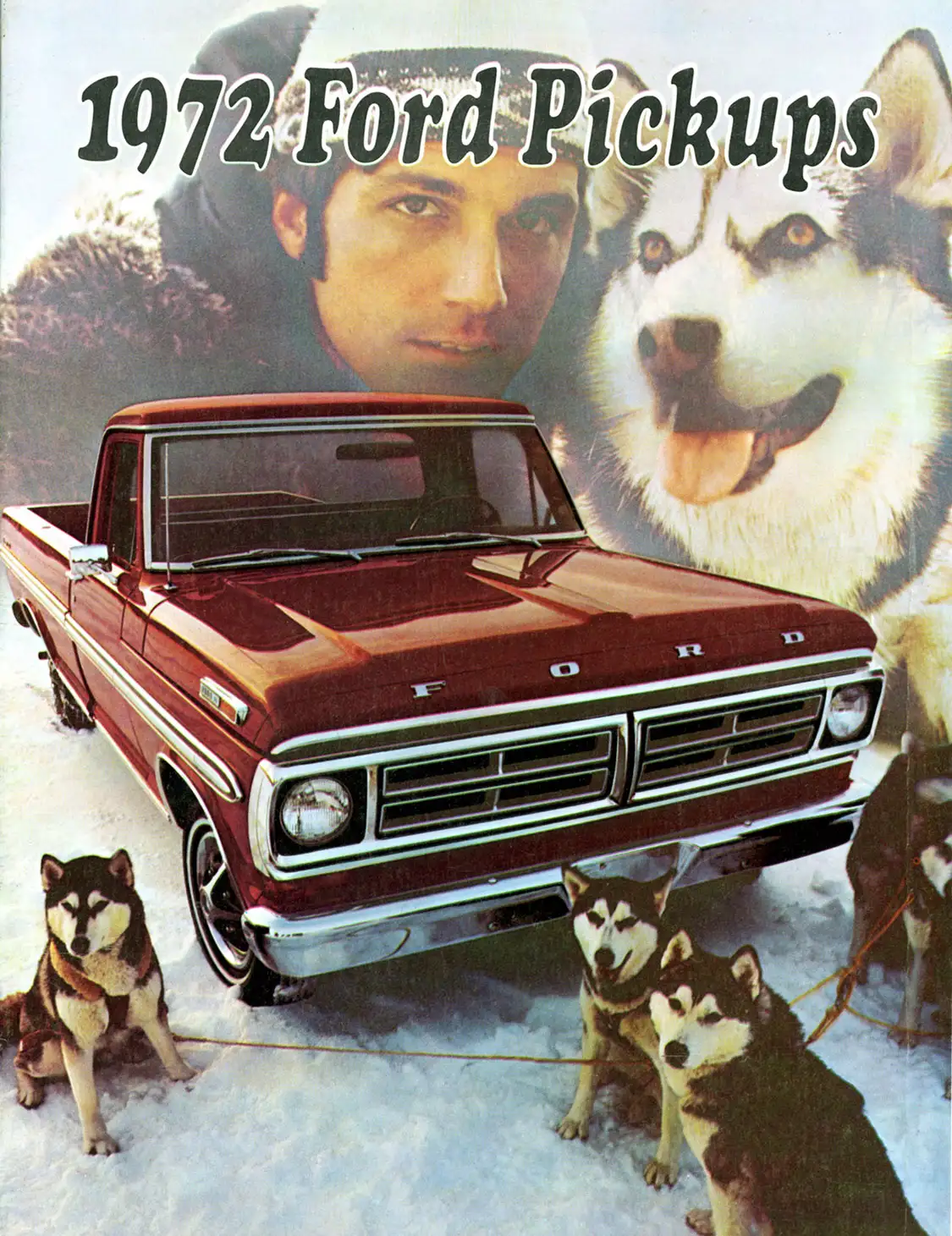 A singer/actor by the name of Elvis marries Priscilla Beaulieu at the Aladdin Hotel in Las Vegas, and Loving v. Virginia is decided in the U.S. Supreme Court, overturning a conviction brought forth due to Virginia’s anti-interracial marriage laws.
A singer/actor by the name of Elvis marries Priscilla Beaulieu at the Aladdin Hotel in Las Vegas, and Loving v. Virginia is decided in the U.S. Supreme Court, overturning a conviction brought forth due to Virginia’s anti-interracial marriage laws.
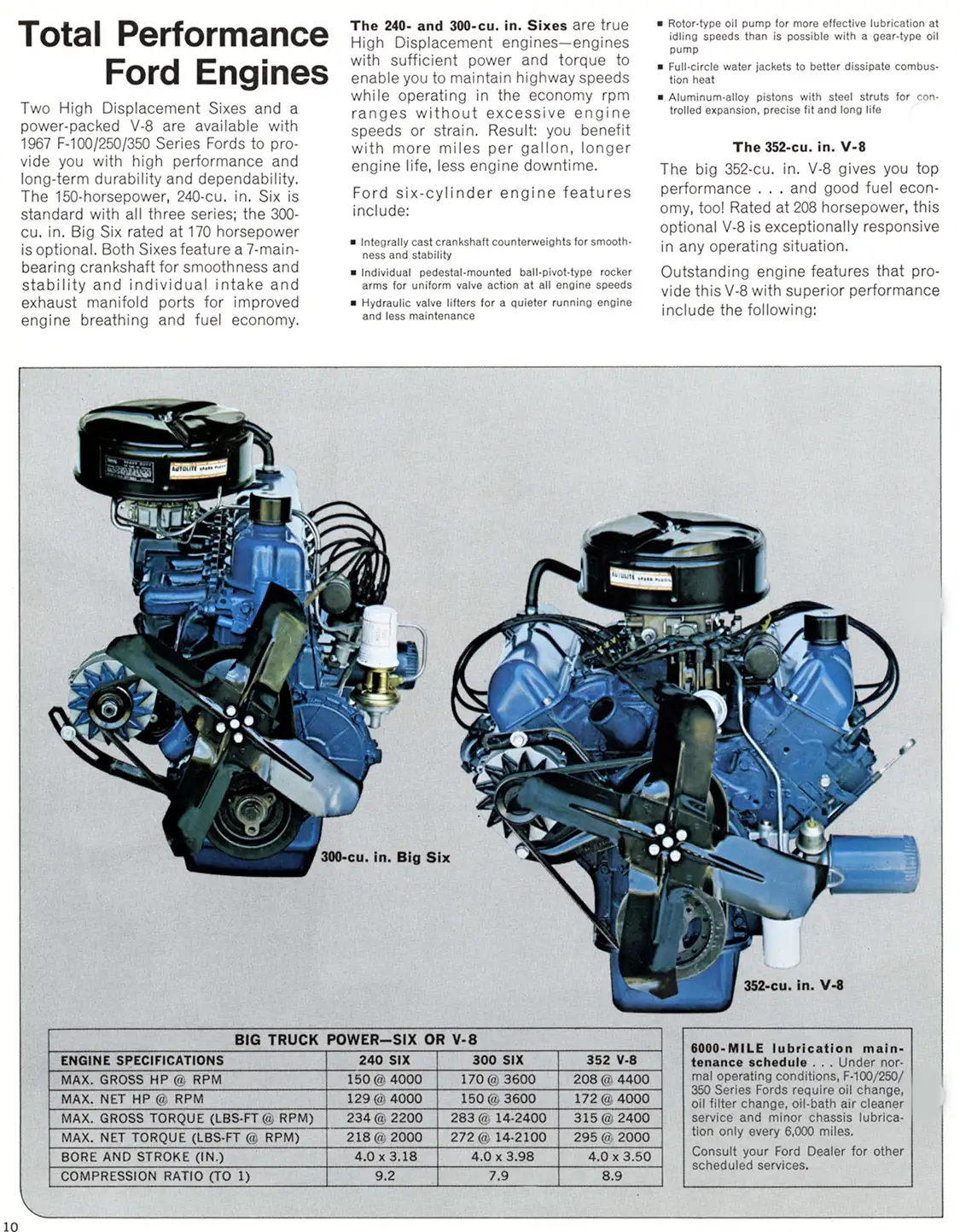 The Big Mac is introduced to the people of Pittsburg, and soon finds its way to McDonald’s restaurants nationwide. Kathrine Switzer, who has probably never had a Big Mac, runs the Boston Marathon as a registered competitor, despite women not being allowed to race according to its organizers (the official rulebook made no mention of gender). It would be five more years until Boston added a women’s race to the marathon.
The Big Mac is introduced to the people of Pittsburg, and soon finds its way to McDonald’s restaurants nationwide. Kathrine Switzer, who has probably never had a Big Mac, runs the Boston Marathon as a registered competitor, despite women not being allowed to race according to its organizers (the official rulebook made no mention of gender). It would be five more years until Boston added a women’s race to the marathon.
Meanwhile in Dearborn, Michigan, Ford had introduced its latest incarnation of the F-Series (How’s that for a smooth segue?). Based on the same chassis as the mechanically revamped ’65 F-Series, the new ’67s were a dramatic take on the future of Ford truck design. A sportier appearance and a pronounced “bump” in the beltline were the most obvious changes, but the interiors were also more car-like this go-around.
Trim packages consisting of Base, Custom Cab and Ranger started off the fifth-generation F-Series’ offerings, although trim names changed somewhat throughout the body style’s run. By the time 1970 rolled around, mid and top-level trim packages were renamed to Sport Custom and Ranger XLT.
In 1968, federal safety mandates required automakers to add side marker reflectors to their vehicles. In the case of Ford trucks, this was accomplished by adding reflectors to the hood and bedsides. Also in 1968 was replacement of the 352 FE with optional 360 and 390 FE engines (170, 240 and 300 cubic-inch I-6s were also available), and the 302 Windsor was also available from 1969-on. This was the first year, too, that one could order a Ford truck with factory air conditioning instead of having to get a third-party setup installed at the dealership. A popular option was the Camper Special, which added camper/trailer wiring, as well as heavy duty cooling and charging system upgrades.
The most drastic change to the fifth-gen trucks came in 1970, with completely a completely new grille design with incorporated wraparound signal lights, as well as changes to the body trim.
As per usual, styleside and flareside boxes were available across the line, and a 4×4 drivetrain was available on F-100 and F-250 models, meaning that no matter what one’s needs, there was a Ford truck that could do the job. Now, check out the rest of the story for some awesome photos and press releases from our friends at the Ford Motor Company Archives!
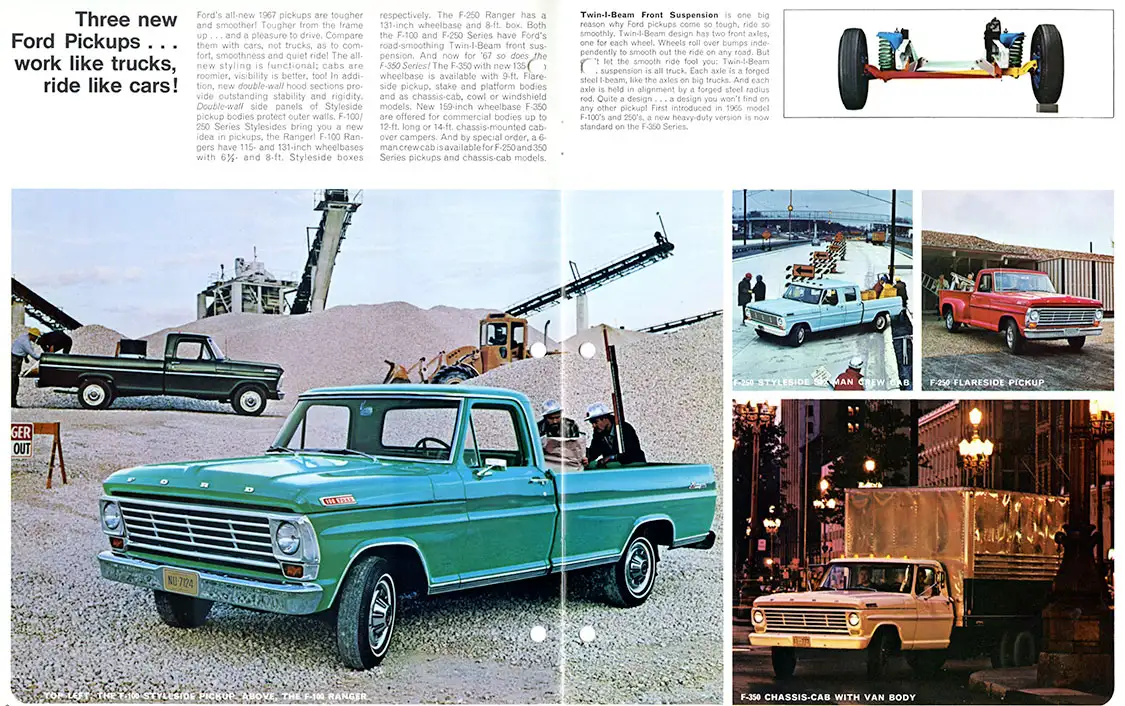
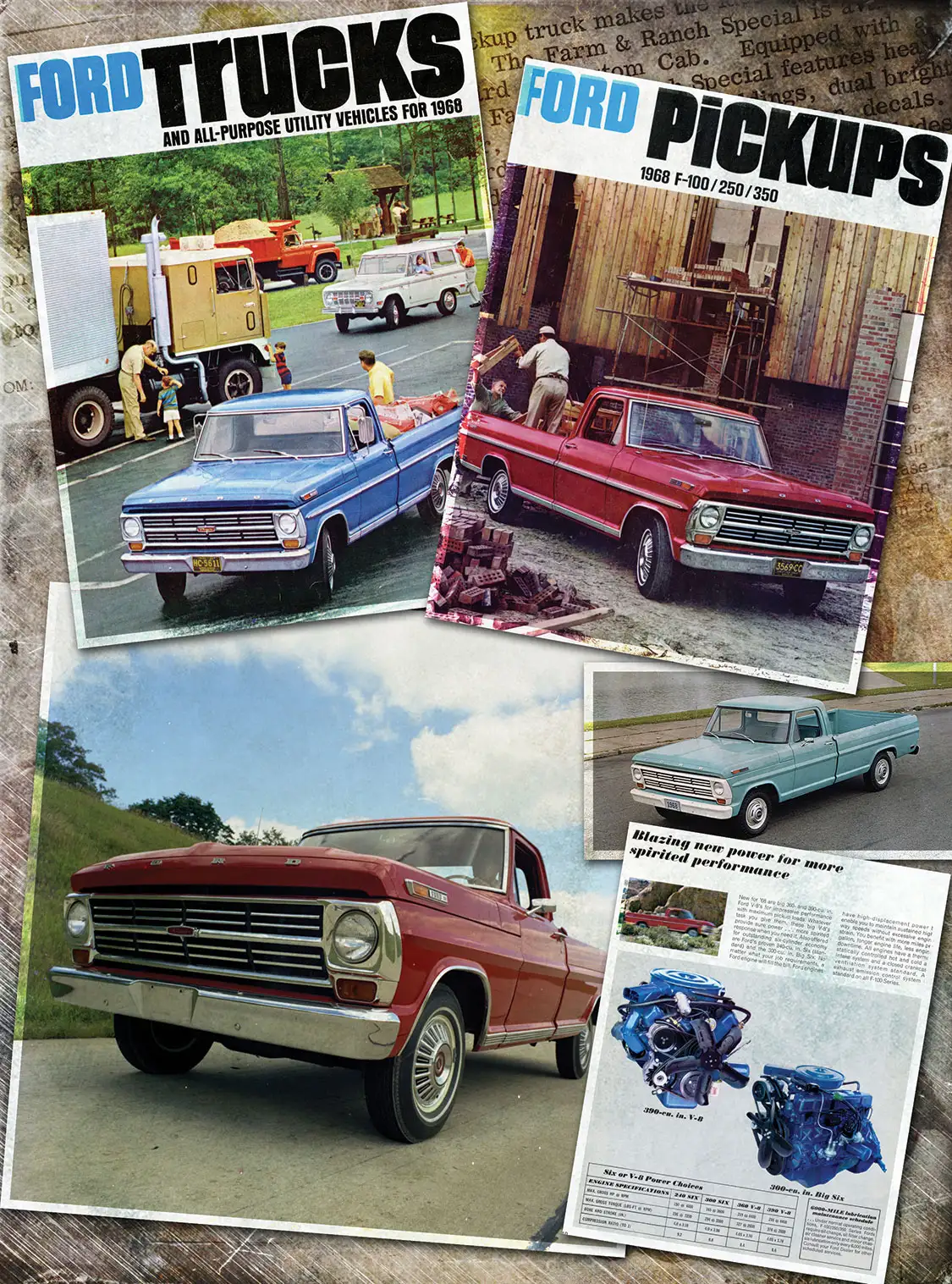
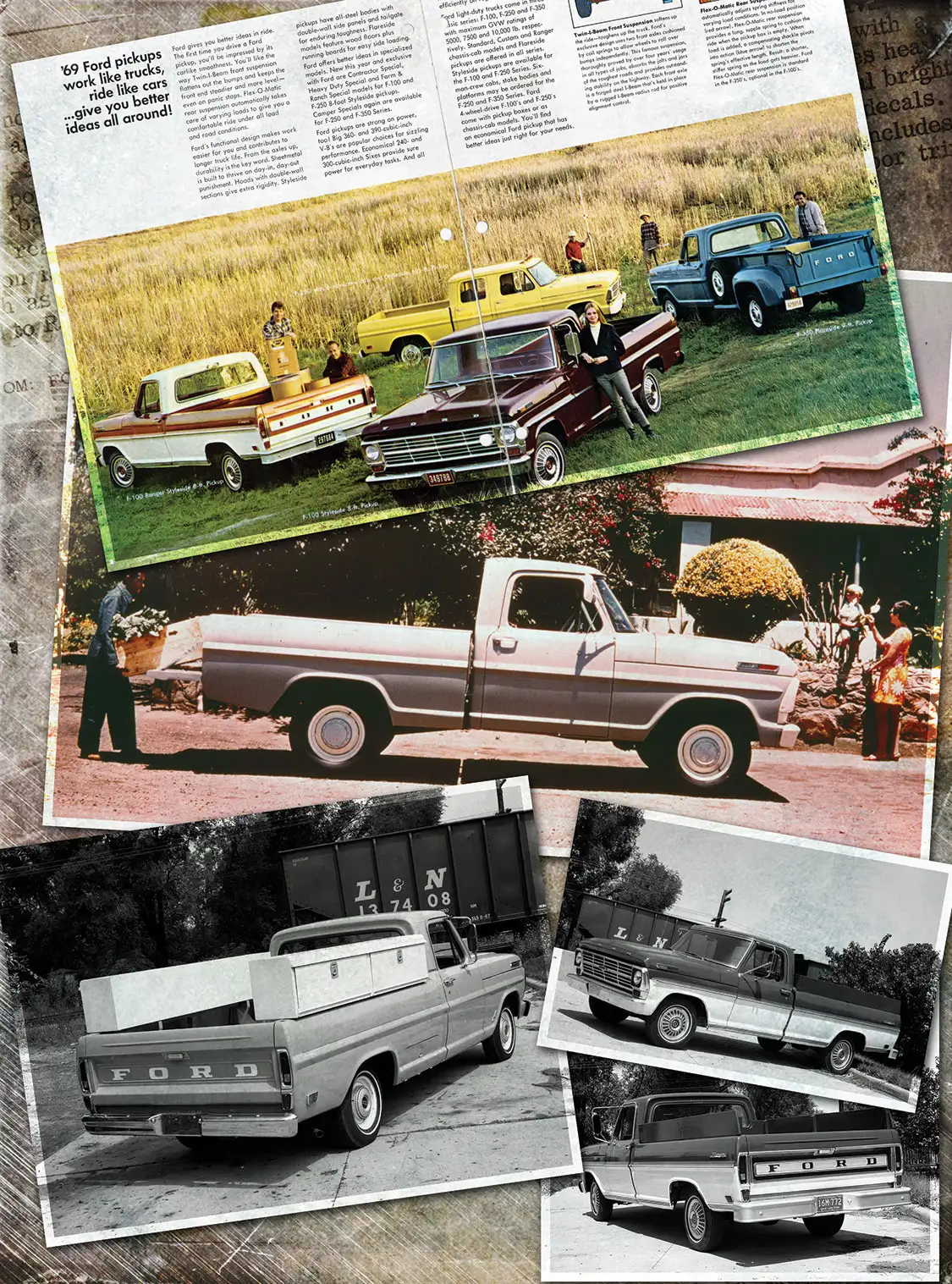
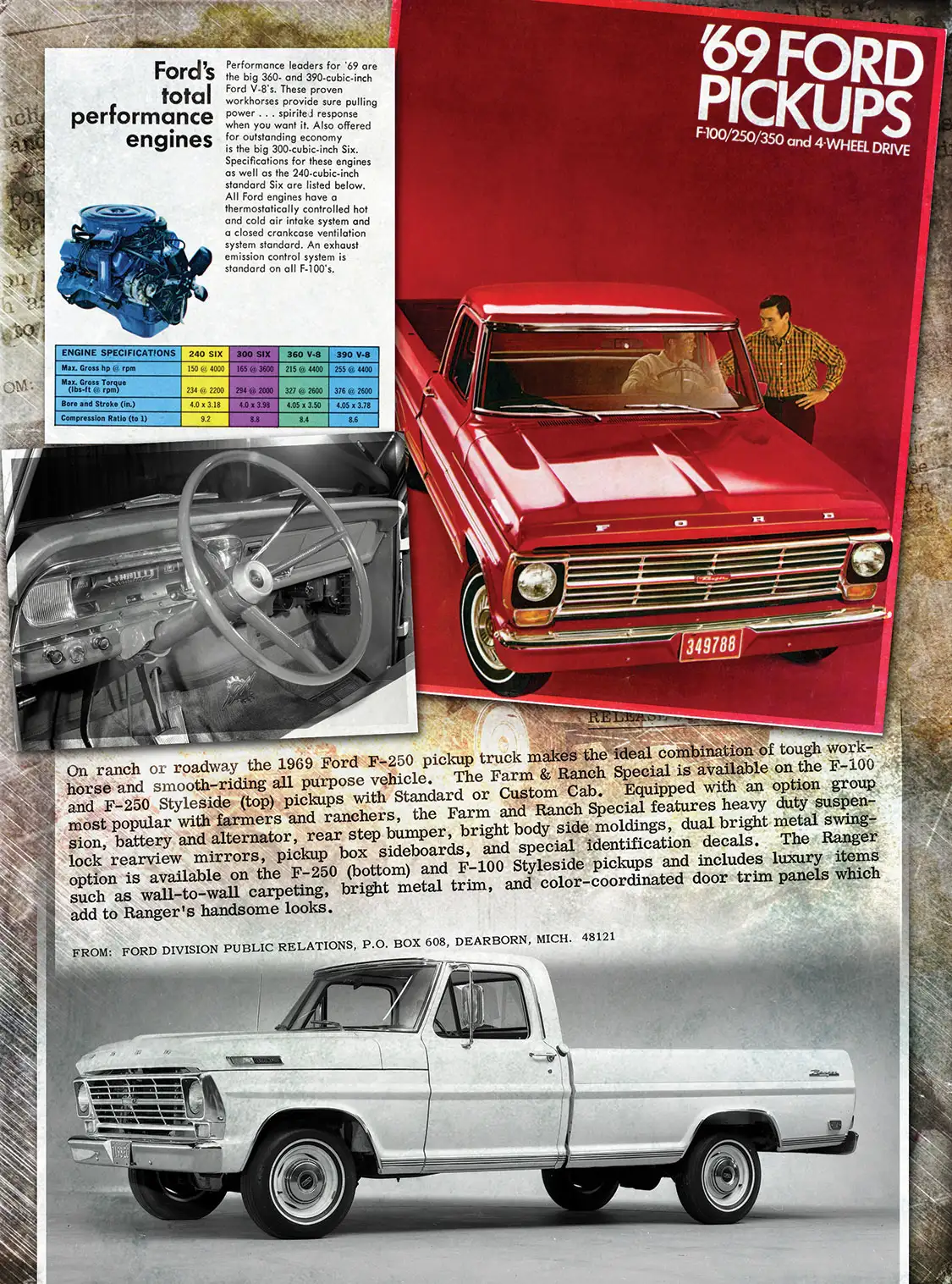
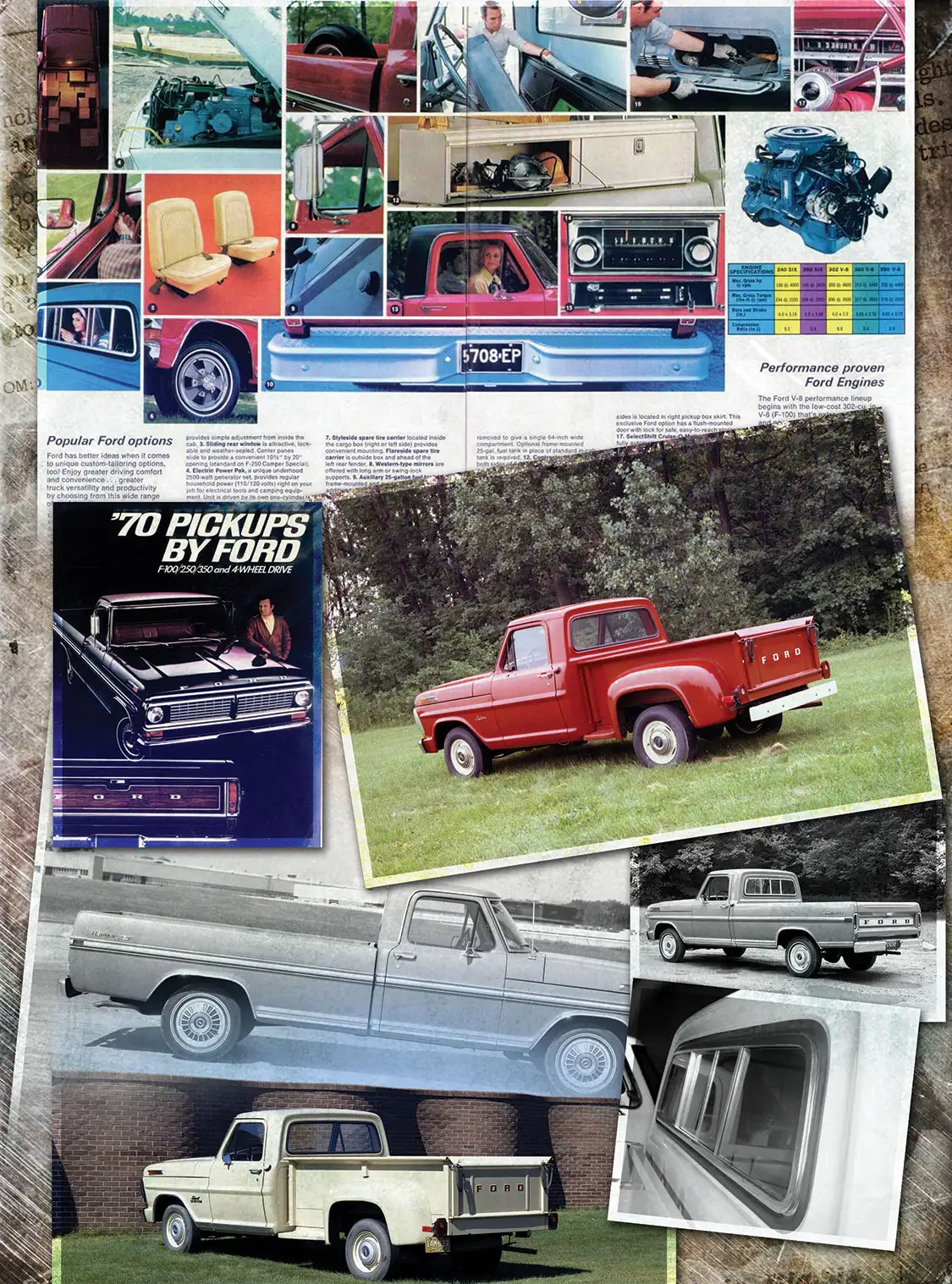
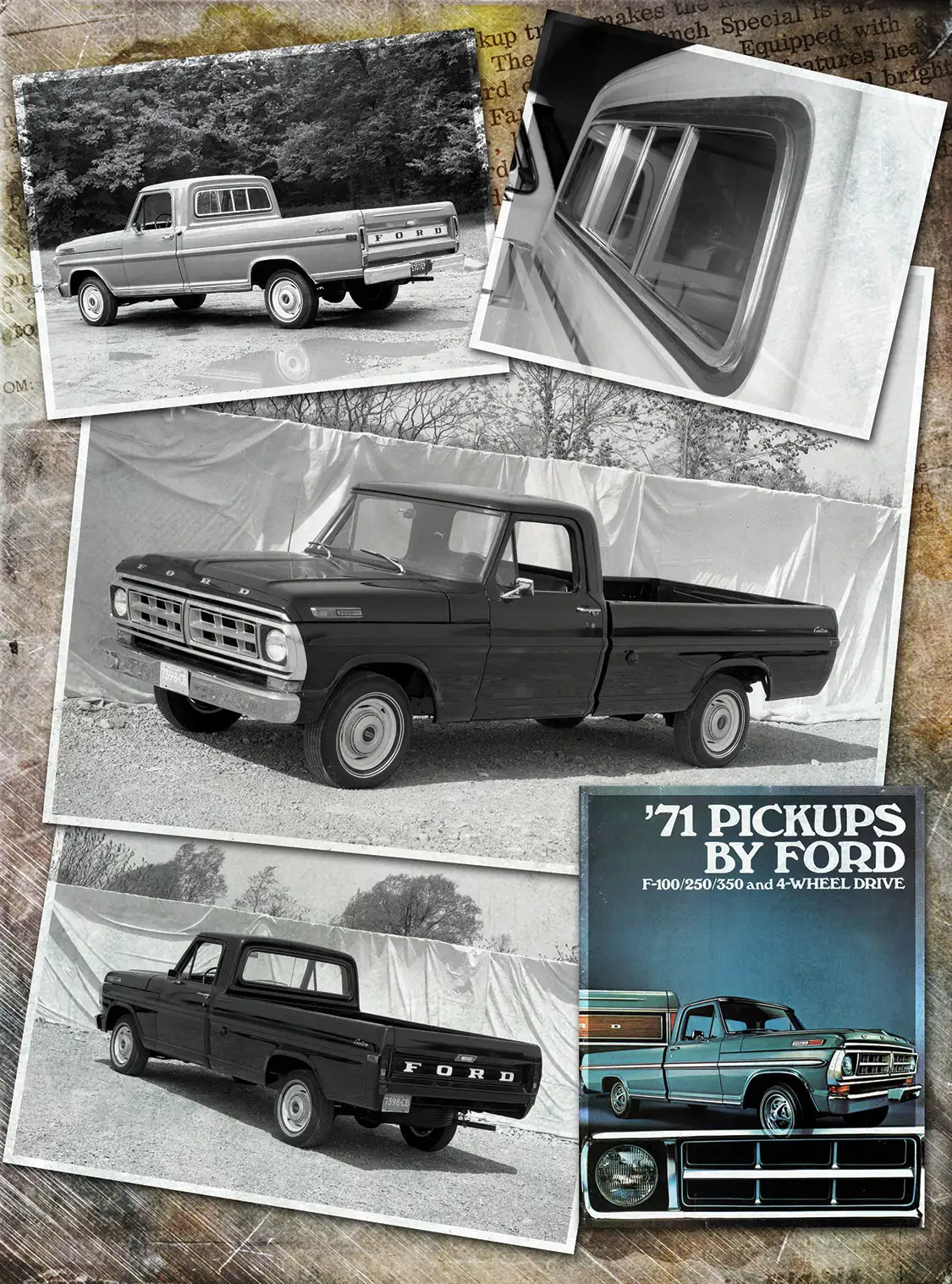
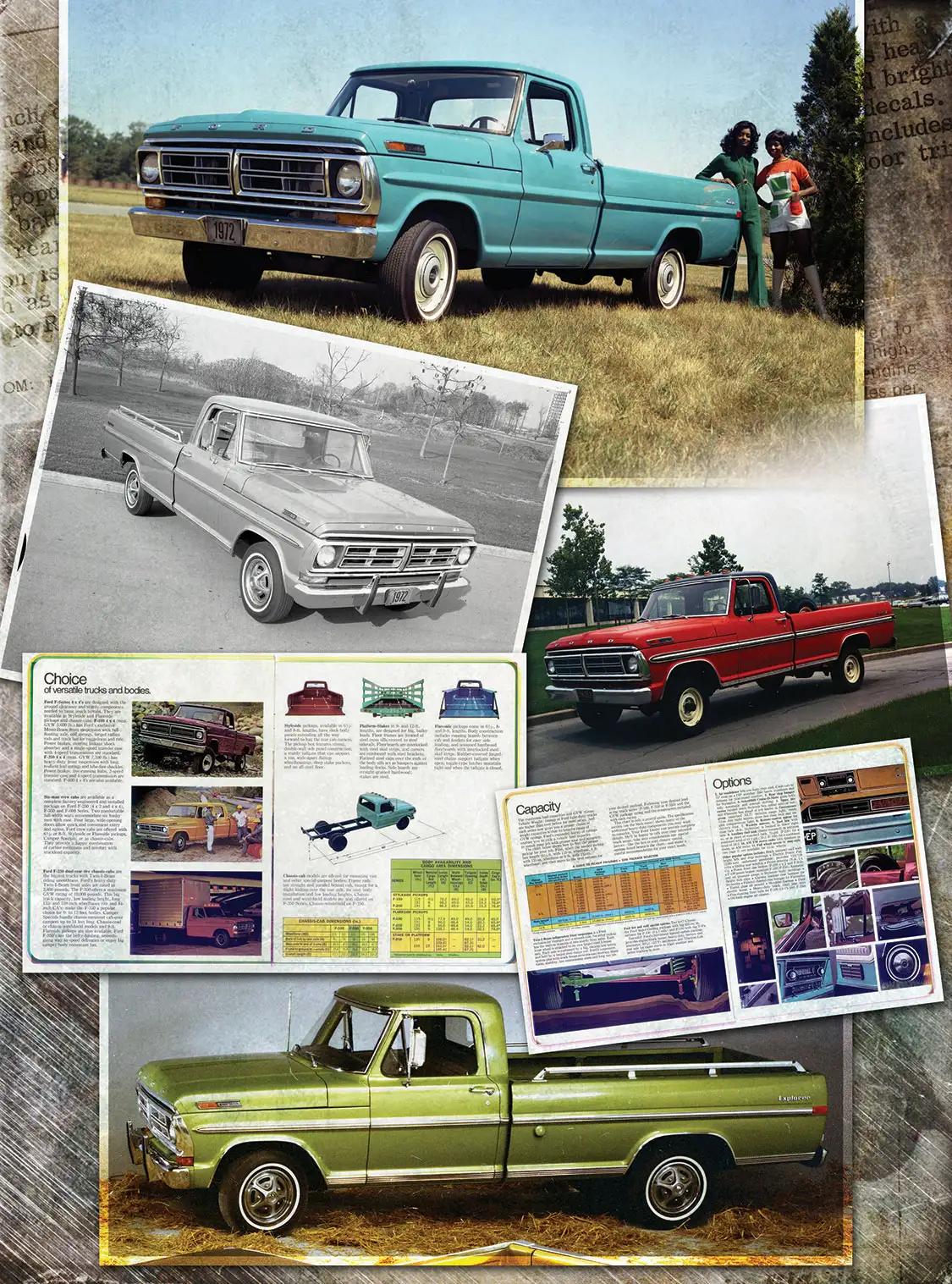
What is the model overview and historical significance of the 1967 Ford F-100?
The 1967 Ford F-100 marked a significant evolution in the lineage of Ford’s light-duty trucks. At first glance, this model appeared entirely new, but it was built upon the foundation of its predecessors from 1961 to 1966, boasting fresh styling cues that set it apart. Key design elements included a striking horizontal crease bisecting the bodywork, angular wheel well openings, and a more detailed grille assembly. The truck was offered in several trim levels: standard cab, Custom Cab, and the upscale Ranger. Notably, 1967 also introduced the first factory-available crew cab, although this feature was limited to ¾-ton and larger pickups.
While the powertrain selection initially remained similar to the previous year’s, significant updates arrived in 1968. The old 352-cubic inch V-8 engine was replaced with new 360- and 390-cubic inch V-8 engines, designed on the FE (Ford-Edsel) architecture. These new engines provided better torque and overall performance. Additionally, the 1968 models complied with new U.S. regulations by including side marker reflectors, enhancing safety.
In 1969, the small-block 302 V-8 was added to the roster, broadening the engine options. By 1970, the F-100 received an updated grille design, and the Ranger XLT was introduced—a trim level that quickly gained popularity. The Ranger XLT featured luxurious touches like color-coordinated full carpeting, pleated cloth and vinyl seats, enhanced insulation, added chrome accents, and a wood-tone tailgate panel.
A special Explorer package debuted as a spring release, exclusively featuring bold Grabber Blue and Explorer Green paint options. For the 1971 model year, minor trim updates occurred, standardizing features like a chrome front bumper and a bright aluminum grille, phasing out painted grilles for basic models. The expanded trims included Custom, Sport Custom, Ranger, Ranger XLT, and the special Explorer.
The 1972 F-100 saw minimal changes before a new generation took over in 1973. Throughout this era, the F-100 continued to embody a shift towards more car-like features in light-duty trucks. Options now included power steering, power brakes, a simulated vinyl roof, remote control mirrors, AM/FM stereo radios, and factory-installed air conditioning. This progression underscored the F-100’s role in bridging the gap between utilitarian workhorses and comfortable, feature-rich vehicles, solidifying its historical significance in the evolution of American trucks.
What are the specifications and values for different engine configurations of the 1967 Ford F-100?
Specifications and Values for Different Engine Configurations of the 1967 Ford F-100
What are the historical sales statistics for the 1967-1972 Ford F-Series?
1967-1972 Ford F-Series Historical Sales Statistics
The 1967-1972 Ford F-Series trucks have seen diverse interest in the market, varying from high-end auctions to more accessible sales. Below are the key figures that outline their historical performance:
These numbers illustrate a wide disparity in sale prices, reflecting differing conditions, models, and levels of restoration. The notable highest sale signifies that certain models, especially those in pristine condition or with historical significance, can command top-dollar amounts. Conversely, the most recent sale at a significantly lower price indicates that more common examples of this range are still accessible to collectors and enthusiasts.
In essence, the 1967-1972 Ford F-Series vehicles remain a dynamic presence in the automotive market, catering to a broad spectrum of buyers. Whether for investment, restoration, or everyday classic car enjoyment, these statistics provide an essential snapshot for potential buyers and enthusiasts alike.
What are the different conditions in which a 1967 Ford F-100 can be found, and what are their respective values?
When looking to buy a 1967 Ford F-100, understanding the different conditions and their corresponding values is essential. Here’s a breakdown:
The value of a 1967 Ford F-100 can significantly vary based on its condition and specific configuration. Whether you’re a classic car enthusiast or a potential buyer, understanding these categories and values will help make informed decisions. Regular market updates and alerts can keep you informed about key changes in these values.
What are some examples of past sales for various Ford F-Series models, including their sale prices and conditions?
Here are several noteworthy sales of Ford F-Series trucks, showcasing a mixture of conditions and sale prices:
These sales illustrate the range of prices and conditions for classic Ford F-Series models that have recently changed hands.
What types of photos are available for the 1967 Ford F-100?
When browsing images of the 1967 Ford F-100, you’ll find a variety of photos that highlight different aspects of this classic truck. Here’s a breakdown of what to expect:
These photos aim to provide a comprehensive visual understanding of the 1967 Ford F-100’s condition and unique attributes. Whether you’re a potential buyer or an enthusiast, these images are an invaluable resource.
How often is the price guide for the 1967 Ford F-100 updated?
The price guide for the 1967 Ford F-100 is refreshed every quarter, ensuring you receive up-to-date market values.
What are some notable features of the 1970 Ford F-100 Ranger XLT?
The year 1967 was an interesting one. The Vietnam War waged on, as did the anti-war protests amid the burgeoning “peace and love” movement of the late ’60s. The The Doors’ self-titled album hits music store shelves, and Super Bowl I takes place, with the Green Bay Packers defeating the Kansas City Chiefs. In other football news, a rising star by the name of O.J. Simpson dazzles crowds as running back for USC, winning the Heisman Trophy the following year.
A singer/actor by the name of Elvis marries Priscilla Beaulieu at the Aladdin Hotel in Las Vegas, and Loving v. Virginia is decided in the U.S. Supreme Court, overturning a conviction brought forth due to Virginia’s anti-interracial marriage laws.
The Big Mac is introduced to the people of Pittsburgh, and soon finds its way to McDonald’s restaurants nationwide. Kathrine Switzer, who has probably never had a Big Mac, runs the Boston Marathon as a registered competitor, despite women not being allowed to race according to its organizers (the official rulebook made no mention of gender). It would be five more years until Boston added a women’s race to the marathon.
Meanwhile in Dearborn, Michigan, Ford had introduced its latest incarnation of the F-Series (How’s that for a smooth segue?). Based on the same chassis as the mechanically revamped ’65 F-Series, the new ’67s were a dramatic take on the future of Ford truck design. A sportier appearance and a pronounced “bump” in the beltline were the most obvious changes, but the interiors were also more car-like this go-around.
Trim packages consisting of Base, Custom Cab and Ranger started off the fifth-generation F-Series’ offerings, although trim names changed somewhat throughout the body style’s run. By the time 1970 rolled around, mid and top-level trim packages were renamed to Sport Custom and Ranger XLT.
The most drastic change to the fifth-gen trucks came in 1970, with a completely new grille design featuring incorporated wraparound signal lights. The introduction of the Ranger XLT trim level brought a host of new features, making it a standout model.
In 1968, Ford made significant changes to the powertrain options. The 352 FE engine was replaced with optional 360 and 390 FE engines, offering better performance and reliability. Additionally, the small-block 302 V-8 was added to the option list for 1969. This was also the first year Ford trucks could be ordered with factory air conditioning, a feature previously available only through third-party installations at dealerships. The popular Camper Special option included camper/trailer wiring, heavy-duty cooling, and charging system upgrades.
As per usual, styleside and flareside boxes were available across the line, and a 4×4 drivetrain was available on F-100 and F-250 models, meaning that no matter what one’s needs, there was a Ford truck that could do the job.
Now, check out the rest of the story for some awesome photos and press releases from our friends at the Ford Motor Company Archives!
What are the different body styles and configurations available for the 1967 Ford F-100?
Per usual, styleside and flareside boxes were available across the line, and a 4×4 drivetrain was available on F-100and F-250 models, meaning that no matter what one’s needs, there was a Ford truck that could do the job.
To provide a clearer picture, here are the specific body styles and configurations available for the 1967 Ford F-100:
This variety ensured that buyers could select a truck tailored to their specific requirements, whether they needed the rugged capability of a 4×4 drivetrain or the classic appeal of a flareside box.
What do the terms “bumpside” and “dentside” mean in relation to the Ford F-100?
When it comes to classic Ford trucks, the terms “bumpside” and “dentside” hold special significance for aficionados. These labels help distinguish between the F-100’s design variations over two key decades: the 1960s and 1970s.
The “bumpside” term is linked to the F-100s produced between 1967 and 1972. This generation is easily recognized by the distinctive ridges, or “bumps,” along the truck’s sides. Originally designed as reinforcement ribs to enhance structural integrity, these features also contributed to the model’s unique aesthetic.
On the other hand, the “dentside” moniker refers to the F-100 trucks manufactured from 1973 to 1979. This era saw a shift in the truck’s design, showcasing smoother body panels with a long, narrow indentation along the side. This subtle groove inspired the “dentside” nickname, popular among truck enthusiasts.
In essence, “bumpside” and “dentside” describe not just physical characteristics but iconic moments in automotive design history, cherished by collectors and fans alike.
How did the design of the dentside F-100 differ from the bumpside?
The transition from the “bumpside” to the “dentside” signifies a shift in truck design focused on modernity and functionality. Here’s how the design of the dentside diverged from that of its predecessor:
These changes marked a generational shift that distinguished the dentside not just in appearance but in overall vehicle performance and safety.
How do the bumpside and dentside F-100s compare in terms of similarities and differences?
The Bumpside and Dentside F-100 trucks may seem similar at first glance, yet they present distinct characteristics that cater to a variety of needs. Here’s a breakdown of their similarities and differences:
In essence, while the Bumpside and Dentside F-100s share a foundational design and versatility, the latter introduced enhancements in durability, performance, and safety, addressing some of the limitations of its predecessor.
Why Are Bumpside F-100s Popular Among Project Truck Enthusiasts?
The bumpside F-100 trucks are a beloved choice for project enthusiasts due to several compelling reasons:
In essence, the bumpside F-100 combines classic charm with modern potential, offering project truck enthusiasts a rewarding and culturally rich endeavor.
How does the choice between a bumpside and dentside F-100 come down to personal preference?
When choosing between a “bumpside” and a “dentside” F-100, the decision ultimately hinges on individual taste and priorities. Both models boast unique appeal and characteristics that cater to different preferences.
Both the bumpside and dentside F-100s hold cherished places in the hearts of enthusiasts. Their rich heritage ensures that, regardless of choice, owners participate in a legacy of American truck history that continues to inspire admiration and collectability.
In the end, it’s not just about specs or looks alone. It’s about what resonates with your individual style and how you envision the ideal driving experience. Whether it’s the classic charm of a bumpside or the refined prowess of a dentside, each model serves as a timeless reflection of personal preference.
What improvements in engine technology were made from the bumpside to the dentside F-100?
The transition from the “bumpside” to the “dentside” F-100 marked significant advancements in engine technology. One of the key improvements was the introduction of more powerful engine options that significantly increased horsepower and torque. The adoption of engines like the Cleveland V8 enhanced these vehicles’ performance, making the later models notably more powerful than their predecessors. This upgrade provided drivers with greater power and efficiency, catering to a demand for more robust performance in the sixth-generation F-100. These enhancements underscore the shift towards a focus on increased engine output and vehicle capability.
What changes were introduced with the dentside Ford F-100?
What Changes Were Introduced with the Ford F-100?
In 1973, the Ford F-100 evolved with its sixth generation, often referred to as the “dentside” due to the distinct side indentation on the truck’s body. This design stood in contrast to the previous “bumpside” models, offering straighter sides for a more streamlined and aerodynamic appearance.
Rather than completely redesigning the F-100, Ford concentrated on improving its functionality. Key changes included:
Maintaining the same chassis as its predecessor allowed Ford to focus these updates on significant internal improvements.
Today, the “dentside” F-100s are cherished in the restoration community. With production figures ranging from 200,000 to 400,000 units annually, they are accessible and relatively easy to restore due to the availability of replacement parts.
However, their widespread presence can be seen as a downside for some enthusiasts, as it makes the model less unique. Nonetheless, the “dentside” F-100 remains a solid entry point for restoration projects, offering a chance to revive a classic with less complexity.
How did Ford’s marketing philosophy change with the bumpside F-100?
With the introduction of the bumpside F-100, Ford shifted its marketing philosophy significantly. Traditionally known for crafting sturdy work trucks, the new approach sought to appeal to a wider demographic. This iteration marked a transformation from being solely a utilitarian vehicle to an attractive option for everyday use.
Key Changes in Marketing Philosophy:
By integrating these elements, Ford intended to position the F-100 as not only a powerful workhorse but also a comfortable and versatile vehicle suitable for a variety of lifestyles. This dual appeal was crucial in redefining the truck’s role from a purely functional asset to a desirable mainstream choice.
Why Are Dentside F-100s Popular Restoration Models Today?
When it comes to classic truck restoration, the 1973-1979 “dentside” F-100s hold a special appeal for enthusiasts. This popularity can be traced back to their unique combination of design, accessibility, and mechanical opportunities.
The “dentside” F-100s, named for the characteristic side indentation along the body, offer a clean and modern aesthetic compared to earlier models. This sleek, straight-sided look gives the truck an aerodynamic style, distinguishing it from the curvier “bumpside” generation that preceded it.
Instead of a complete design overhaul, Ford focused on enhancing the functionality of this generation. The “dentside” trucks carried over the chassis from the previous models, allowing for refinements that included improved safety features and higher-quality sheet metal. Additionally, more powerful V8 engine options were available, offering a combination of vintage charm and enhanced performance that appeals to restoration experts.
One of the most appealing aspects for restorers is the availability of both the trucks themselves and their parts. With production numbers ranging between 200,000 to 400,000 units annually, finding a “dentside” F-100 is relatively easy. This widespread availability means that restorable vehicles and high-quality replacement parts are plentiful, making the task less daunting and more cost-effective.
For new restorers entering the classic truck scene, the “dentside” F-100s serve as an excellent starting point. While their abundance might lead some to view them as common, this very trait makes them ideal for those looking to gain experience or enjoy a project without a steep financial or time investment.
In summary, the “dentside” F-100s are popular for restoration due to their unique design, functional improvements, and the ease of finding both trucks and parts. This balance of style, performance, and practicality ensures their continued appeal to both novice and seasoned restoration aficionados.
What safety features were added in the dentside F-100?
The “dentside” F-100 introduced significant safety enhancements that addressed key concerns for drivers. First, the relocation of the gas tank was a crucial improvement. It was originally positioned behind the seat in the cab, posing a direct hazard in accidents. In the updated design, the tank was moved to a safer spot between the frame rails under the bed, significantly reducing the risk to the driver.
Additionally, this generation was the first to feature disk brakes, which significantly boosted the vehicle’s stopping power and reliability. These advancements collectively made the dentside F-100 a much safer option for drivers of its time.
What functional improvements were made in the dentside F-100?
The sixth-generation F-100, commonly known as the “dentside,” made its debut in 1973, focusing on functional enhancements rather than a complete design overhaul.
Today, “dentside” models are favored restoration projects due to their widespread availability and the ease of sourcing quality parts. Their practicality makes them ideal entry points for new restorers, though some may argue they lack uniqueness compared to more rare models. Despite this, the blend of improvements ensures they remain a popular choice for vintage truck enthusiasts.
What trim levels were available for the bumpside F-100?
Trim packages consisting of Base, Custom Cab, and Ranger started off the fifth-generation F-Series’ offerings, although trim names changed somewhat throughout the body style’s run. Initially, the bumpside F-100 was produced with these three trim levels, offering variations in spec and body style options.
Compared to its predecessors, this generation introduced significant updates, such as an overhauled grille style. It was also the first to provide now-standard features directly from the factory, like air conditioning, marking a significant step forward in comfort and convenience.
By the time 1970 rolled around, mid and top-level trim packages were renamed to Sport Custom and Ranger XLT. These changes reflect the evolution of the F-100’s offerings, catering to shifting consumer preferences and enhancing the model’s appeal during its production years.
What were the distinguishing features of the bumpside F-100 compared to previous generations?
Compared to earlier versions, the bumpside F-100 introduced a redesigned grille style and was the first to feature factory-installed amenities like air conditioning.
How did the trim levels change throughout the production years?
The trim levels experienced slight changes over the years, yet they continued to offer similar specifications and body style options.
What were the initial trim levels for the bumpside F-100?
The initial trim levels included the standard cab, custom cab, and ranger.
What are the distinguishing features of the bumpside Ford F-100?
The 1967 Ford F-100 marked a significant evolution in the lineage of Ford’s light-duty trucks. At first glance, this model appeared entirely new, but it was built upon the foundation of its predecessors from 1961 to 1966, boasting fresh styling cues that set it apart. Key design elements included a striking horizontal crease bisecting the bodywork, angular wheel well openings, and a more detailed grille assembly. The truck was offered in several trim levels: standard cab, Custom Cab, and the upscale Ranger. Notably, 1967 also introduced the first factory-available crew cab, although this feature was limited to ¾-ton and larger pickups.
With the introduction of the “bumpside” style from 1967 to 1972, Ford added distinctive bulges along the truck bed, giving the F-100 its memorable nickname. These bulges were a defining design feature intended to enhance visual appeal and differentiation from other models of the era. The wider stance of the bumpside design lent the truck a more muscular appearance.
Under the hood, the bumpside F-100 offered a variety of engine options. Choices ranged from the 240 cubic inch inline-six to the robust 300 cubic inch inline-six, as well as a powerful 252 cubic inch V8, catering to different performance needs. Depending on the configuration, the F-100 could produce up to 200 horsepower, making it both a capable workhorse and a powerful street machine.
This generation also signaled a shift in Ford’s marketing philosophy. By emphasizing interior comfort and convenience features, such as air conditioning, the F-100 aimed to appeal to a broader audience beyond traditional truck buyers. This approach was evident in the refined interior of the Custom Cab and Ranger trims, highlighting Ford’s desire to position the F-100 as a viable everyday vehicle.
The bumpside F-100’s iconic status in American automotive culture remains evident today, as it continues to be a popular choice for restorations and modern engine swaps. Its blend of classic styling and potential for customization keeps it a favorite among enthusiasts, celebrating the enduring legacy of this classic truck.
Why are bumpside F-100s popular among enthusiasts today?
Enthusiasts are drawn to the bumpside F-100 for its classic design and nostalgic value, making it a favored choice for restorations and modern engine swaps, blending vintage charm with contemporary performance.
What trim levels and factory features were introduced with the bumpside F-100?
Initially, the bumpside F-100 was available in standard cab, custom cab, and ranger trims. It was also the first to offer features like air conditioning straight from the factory.
How did Ford’s marketing strategy change with the bumpside F-100?
Ford shifted its marketing strategy to capture a wider consumer base by highlighting interior comfort and features alongside the truck’s size and power, positioning it as a suitable everyday vehicle rather than just a work truck.
What engine options were available for the bumpside F-100, and what were their capabilities?
The truck offered a variety of engines, including two inline-six options (240 and 300 cubic inches) and a 252 cubic inch V8, capable of delivering around 200 horsepower, making it both a robust work vehicle and a powerful street option.
What are the distinctive design features of the bumpside F-100?
The bumpside F-100 is known for its unique side bulges, which were added to enhance the truck’s visual appeal and set it apart from other models of its time.
How have modern restorations affected the appeal and functionality of classic Bumpside Ford trucks?
The transformation of classic Bumpside Ford trucks through modern restorations has considerably enhanced their appeal and functionality. These trucks, known for their distinctive styling, now benefit from a fusion of vintage aesthetics with contemporary features.
By blending cutting-edge technology with classic design elements, modern restorations have not only enhanced the performance of Bumpside Ford trucks but have also broadened their attractiveness to a new generation of truck aficionados.
How did the Bumpside Ford trucks influence the market for pickup trucks?
The Bumpside generation of Ford trucks marked a pivotal moment in the evolution of pickup trucks, significantly altering their role in the automotive world. This shift contributed to pickups becoming a staple in consumer households, expanding beyond their traditional roles as mere workhorses.
One of the most notable innovations introduced during this era was the twin I-beam front suspension. Initially launched in 1965, this system revolutionized the experience of driving a truck. It allowed pickups to boast the rugged utility expected of them, while also offering a ride quality reminiscent of passenger cars. This dual-purpose capability made trucks appealing not just for work or farm use, but also for everyday driving, thereby broadening their appeal.
Another factor that increased the attractiveness of these trucks was the introduction of a diverse range of engine options. With up to six engines available, consumers had the flexibility to choose a configuration that best suited their needs, whether they required power, efficiency, or a balance of both. This variety enabled trucks to cater to a wider spectrum of driver preferences and requirements.
By blending rugged utility with comfort and versatility, Bumpside trucks helped reshape consumer perceptions, encouraging many to view pickups not only as necessary tools but also as practical, everyday vehicles. This shift in perspective laid the groundwork for pickups to become a dominant segment in the automotive market, appealing to both traditional users and new consumers seeking a blend of function and comfort.
Why are certain body styles of classic Ford trucks more valuable to collectors?
Collectors often value certain body styles of classic Ford trucks more than others due to their rarity and unique features. While trucks from the 1973-1979 era have a well-noted resilience against rust, increasing their availability today, not all body designs were produced equally.
Standard cab vehicles, being the most commonly manufactured, are relatively easy to find. However, models like the extended cab and crew cab were produced in far fewer numbers. This limited production makes them more scarce and therefore more desirable to collectors who seek distinctiveness and rarity in their collections.
Furthermore, these rarer body styles often offer enhanced versatility, which can appeal to both nostalgia-driven collectors and those interested in the practical aspects of classic vehicles. In essence, the combination of limited availability and the distinct advantages these body styles offer contributes to their increased value in the collector’s market.
What factors should be considered when deciding between a Bumpside and a Dentside Ford truck?
When choosing between a Bumpside (1967-1972) and a Dentside (1973-1979) Ford truck, there are several factors to weigh. Each generation has its characteristics that appeal to different types of enthusiasts. Here’s a breakdown to help guide your decision:
Ultimately, your decision should be guided by personal preference. Whether it’s the nostalgic allure of the Bumpside’s design or the sturdier, more enduring build of the Dentside, both options provide a unique blend of history and potential for customization. Consider what features matter most to you—be it aesthetics, durability, or the thrill of restoring a classic truck—as you embark on your purchase journey.
What do the terms “Bumpside” and “Dentside” mean in relation to classic Ford trucks?
When diving into the world of classic Ford trucks, you’ll likely come across the terms “Bumpside” and “Dentside.” These nicknames highlight the unique body styles of Ford’s F-Series trucks from the late 1960s and 1970s, each marking a significant era in automotive design.
The “Bumpside” design pertains to the Ford F-Series trucks produced between 1967 and 1972. This fifth-generation model earned its nickname from the prominent horizontal crease running along the truck’s sides. Starting at the front fender and tracing back to the rear, this bumped-out line adds a distinctive character to its otherwise sleek profile.
In 1973, Ford transitioned to the sixth-generation F-Series, introducing the “Dentside” design. Contrasting sharply with its predecessor, the Dentside features a recessed concave line that stretches from the front fender to the rear marker lights. This indentation gives the trucks a cleaner, more streamlined appearance while maintaining a classic silhouette.
These stylistic elements not only made these generations of F-Series trucks highly desirable among collectors but also marked a pivotal shift in the design ethos of Ford’s iconic lineup.
How did the interior and configuration options of the Dentside Ford trucks enhance their appeal?
The appeal of the Dentside Ford trucks from the late 1970s skyrocketed due to significant improvements in interior comfort and varied configuration options. These trucks prioritized driver and passenger comfort by enhancing interior design elements, making for a more enjoyable ride.
Here’s how:
These strategic enhancements positioned the Dentside Ford trucks as highly versatile, catering to a broader audience and establishing them as a leading choice in the market.
What design changes were introduced with the Dentside Ford trucks in the sixth-generation F-Series?
The sixth-generation F-Series, introduced in 1973, brought several notable design changes that defined the Dentside Ford trucks. Key among these was the shift from a convex to a concave beltline, which gave the trucks their distinctive “Dentside” appearance. This new design feature created a recessed line running from the front fender to the rear marker lights, adding depth to the truck’s profile.
Additionally, the grille was redesigned with an indentation that highlighted this recessed feature, contributing to a more rounded front end. The overall aesthetic was cleaner and more streamlined, marked by the hood’s cutline aligning smoothly with the crease of the fender. These design updates were also adopted in the second generation of the Ford Bronco, albeit briefly.
What are the design features of the Bumpside Ford trucks from the fifth-generation F-Series?
Meanwhile in Dearborn, Michigan, Ford had introduced its latest incarnation of the F-Series (How’s that for a smooth segue?). Based on the same chassis as the mechanically revamped ’65 F-Series, the new ’67s were a dramatic take on the future of Ford truck design. A sportier appearance and a pronounced “bump” in the beltline were the most obvious changes, but the interiors were also more car-like this go-around.
This distinctive “bump” along the truck’s beltline is where the nickname “Bumpside” originates. The crease starts at the front fender and extends to the rear, creating a unique profile that sets these trucks apart from previous generations. The fifth-generation F-Series, spanning from 1967 to 1972, embraced this design innovation, marking a pivotal shift in the truck market by helping pickups transition into mainstream consumer vehicles rather than being confined to work and farm use.
Trim packages consisting of Base, Custom Cab, and Ranger started off the fifth-generation F-Series’ offerings, although trim names changed somewhat throughout the body style’s run. By the time 1970 rolled around, mid and top-level trim packages were renamed to Sport Custom and Ranger XLT.
Complementing the Bumpside’s exterior was a new grille design, which incorporated headlights and turn signals, enhancing its desirable appearance, especially on the earlier models. This grille was completely revamped in 1970, featuring wraparound signal lights that added a modern touch to the classic design.
Adding to the appeal, the innovative twin I-beam front suspension, initially introduced in the previous generation, was retained. This feature allowed Ford to market the F-Series with the promise that it “works like a truck, rides like a car.”
The most drastic change to the fifth-gen trucks came in 1970, with a completely new grille design with incorporated wraparound signal lights, as well as changes to the body trim.
With six available engines, the fifth-generation F-Series broadened its attraction to a wider audience, catering to varying needs and preferences. This was further supplemented by the available styleside and flareside boxes and an optional 4×4 drivetrain on F-100 and F-250 models, ensuring that no matter what one’s needs, there was a Fordtruck that could do the job.
What role did engine options play in attracting consumers?
Offering six different engines, the Bumpside Ford catered to a diverse range of consumer needs, making it a versatile choice for buyers looking for both power and efficiency in a pickup truck.
How did the suspension system influence the truck’s appeal?
The twin I-beam front suspension, introduced earlier, promised a comfortable ride akin to a car, broadening the appeal of the F-Series to a wider audience by offering a smoother driving experience.
What are the specific design features that contribute to the Bumpside Ford’s appearance?
The design includes a unique grille with integrated headlights and turn signals, which, along with the convex metalwork on the sides, enhances its classic and desirable look.
What was the impact of the Bumpside design on the truck market?
The Bumpside design marked a pivotal shift in the truck market, evolving pickups from primarily work and farm vehicles into mainstream consumer vehicles, making them more appealing for general use.
What is the origin of the “Bumpside” nickname?
The “Bumpside” nickname originates from the distinct crease that runs along the truck’s beltline, extending from the front fender to the rear, giving the truck its notable appearance.
Share Link